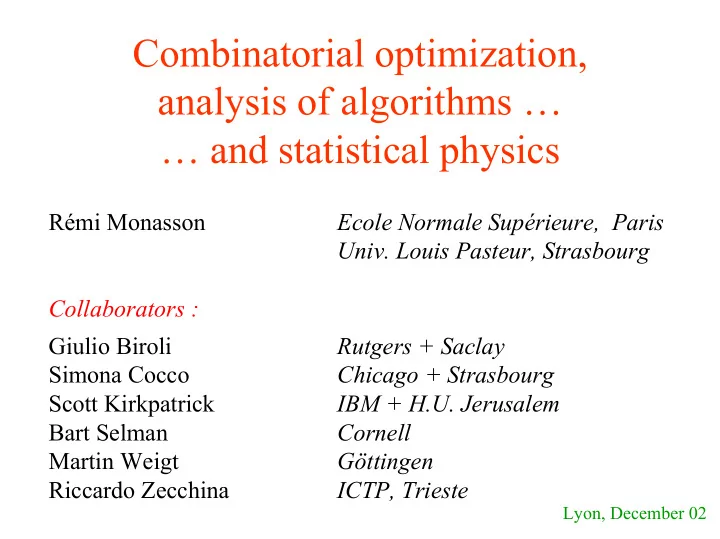

Combinatorial optimization, analysis of algorithms … … and statistical physics Rémi Monasson Ecole Normale Supérieure, Paris Univ. Louis Pasteur, Strasbourg Collaborators : Giulio Biroli Rutgers + Saclay Simona Cocco Chicago + Strasbourg Scott Kirkpatrick IBM + H.U. Jerusalem Bart Selman Cornell Martin Weigt Göttingen Riccardo Zecchina ICTP, Trieste Lyon, December 02
Two examples of optimization problems: Traveling salesman Graph coloring N cities European + distances union between cities Tour = visit of every city once and return to initial city non planar graphs? Shortest tour?
Relationship with statistical physics I. Equilibrium minimum of a cost function = ground state of a classical Hamiltonian � (quasi-solutions = excited states …) distribution of instances = quenched disorder in interactions � list of problems: � From 1984 to 1990 traveling salesman (non Euclidean) Anderson, De Dominicis, Fu, Kirkpatrick, - Krauth, Mézard, Orland, Parisi, Sherrington, graph partitioning - Sourlas, Toulouse … optimal matching - Hopfield, Amit, Gutfreund, Sompolinsky, neural networks - Gardner … extremal distribution of correlated variables? Replicas … � Example : Edwards-Anderson model on square lattice: 2 N correlated energy levels! [ ] ∑ N spins S i = − H J, S J S S ij i j low temperature : 2 N random couplings J ij i, j distribution of minimum, quasi-minima …
Relationship with statistical physics II. Dynamics Algorithm = sequence of computation rules º dynamical evolution of the instance � L = 6, 1, 18, 7, 10, 2, 3, 15 Example : 1; 6, 18, 7, 10, 2, 3, 15 sorting 1, 2; 6, 18, 7, 10, 3, 15 ……. � Analysis = calculation of the running time Knuth ’60 Nb. of comparisons to find min of k numbers = k-1 Nb. of comparisons = (N-1)+(N-2)+…+1 = N(N-1)/2 � Different classes of optimization algorithms: � local search similarity with physical dynamics (Monte Carlo, simulated annealing, … cf. vitreous transition) incomplete (cannot prove the absence of solution) � global search no physical origin (designed by computer scientists to be complete ) non Markovian (memory effects), non local (jumps in phase space)
What is the Satisfiability problem? American Scientist, Volume 85, Number 2, Pages 108-112, March-April 1997. http://www.amsci.org p = true if Peru ambassador is invited, false otherwise
Satisfiability of (random) Boolean constraints ( w or NOT x or y ) 3-SAT NP-complete and ? (and >3) ( NOT w or x or z ) and 2-SAT P ( x or y or NOT z ) nb. of clauses α = nb. of variables Mitchell, Selman, Levesque ‘92 Chao, Franco ‘86, ‘90 Crawford, Auton ‘93 Chvatal, Szmeredi ‘88 Gent, Walsh ‘94
The Phase transition of 3-SAT sat unsat α C ≈ 4.3 phase transition! α C > 3.26 • α C < 4 . 51 Rigorous results • • transition region width → 0
= x SAT, a disordered spin system ( at zero temperature)
Spin glasses on random graphs Ball problem * frustration ... ( ) ( ) ( ) ∨ ∧ ∨ ∧ ∨ p q q r r p ( ) 1 = − + + + E S S S S S S 3 p q q r r p 4 * |J| = N -1/2 |J| = 1 |J| = 1 no geometry infinite D geometry finite D geometry Multi-spins interactions (K-SAT = K-body) *
Recommend
More recommend